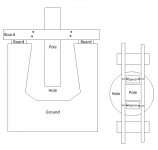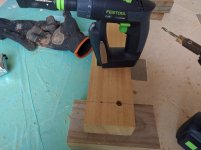chappardababbar
Member
- Joined
- Nov 28, 2014
- Messages
- 62
I'm going to try to build a fence that looks like this next weekend:
https://uk.pinterest.com/pin/327073991671443335/
Building it in iroko. I have the sketchup in case anyone is interested. The posts are 2x2, the, cross planks are 4x2 and 8x2
Here is how I am planning on building it please do let me know your comments:
- Timber going to be planed and squared by a local joiner and delivered in 4.7m lengths
- Going to lay out the timber planks on the floor in the finished arrangement
- Will mark up exactly where I want the staggered cuts to be and make a single cut in each plank at the start of the gap with the HKC55 and cross cut rail. (by the way, I need to cross cut 8 inches...assuming the 250mm guide rail will be fine). Will put planks on a saw horse with stablisiing planks on it, to do this
- Will lay down and line up the outer two posts against the timber and mark up for DF500 dominos. Going to use the 10mm ones. 4x dominos for each join
- Make the holes with the domino, in the posts as well as the planks
- Bolt a post to each brick pier, these will not go into the ground
- Dig holes 50cm deep for the remaining three posts
- Use a string to give me the alignment between the outside posts, and will pour concrete into the holes and line up the posts to the string as well as use a spirit level to ensure each post is dead level
At this point, the posts are up, I've cut the planks into the staggered pattern and so I have two parts to each plank, and I have the domino holes cut into the outer posts. Now...
I will line up the shorter length of plank and insert the domino into the outer post, and use it to mark up the second post. Then, I will remove the plank and make the domino holes in the other side of the plank as well as the post (which I will do in situ)
Also, once I line up the cross plank to the second post (which is in the ground, and therefore not at the same height as the reference posts which are against the brick wall) I will cut the three middle posts to size using the HKC55, in situ.
Basically going to repeat this process, until it's done. Checking with a spirit level to ensure it's level as i go along, and using a 1/2 inch spacer to ensure even spacing between the cross planks
Will glue it all up with gorilla glue, sand down, stain.
Any comments or improvements I can make? Will the 4x dominos at each join be strong enough? Will the glue hold? Will i have difficultly making domino holes and lining them up in situ?
All thoughts appreciated
Yasir
https://uk.pinterest.com/pin/327073991671443335/
Building it in iroko. I have the sketchup in case anyone is interested. The posts are 2x2, the, cross planks are 4x2 and 8x2
Here is how I am planning on building it please do let me know your comments:
- Timber going to be planed and squared by a local joiner and delivered in 4.7m lengths
- Going to lay out the timber planks on the floor in the finished arrangement
- Will mark up exactly where I want the staggered cuts to be and make a single cut in each plank at the start of the gap with the HKC55 and cross cut rail. (by the way, I need to cross cut 8 inches...assuming the 250mm guide rail will be fine). Will put planks on a saw horse with stablisiing planks on it, to do this
- Will lay down and line up the outer two posts against the timber and mark up for DF500 dominos. Going to use the 10mm ones. 4x dominos for each join
- Make the holes with the domino, in the posts as well as the planks
- Bolt a post to each brick pier, these will not go into the ground
- Dig holes 50cm deep for the remaining three posts
- Use a string to give me the alignment between the outside posts, and will pour concrete into the holes and line up the posts to the string as well as use a spirit level to ensure each post is dead level
At this point, the posts are up, I've cut the planks into the staggered pattern and so I have two parts to each plank, and I have the domino holes cut into the outer posts. Now...
I will line up the shorter length of plank and insert the domino into the outer post, and use it to mark up the second post. Then, I will remove the plank and make the domino holes in the other side of the plank as well as the post (which I will do in situ)
Also, once I line up the cross plank to the second post (which is in the ground, and therefore not at the same height as the reference posts which are against the brick wall) I will cut the three middle posts to size using the HKC55, in situ.
Basically going to repeat this process, until it's done. Checking with a spirit level to ensure it's level as i go along, and using a 1/2 inch spacer to ensure even spacing between the cross planks
Will glue it all up with gorilla glue, sand down, stain.
Any comments or improvements I can make? Will the 4x dominos at each join be strong enough? Will the glue hold? Will i have difficultly making domino holes and lining them up in situ?
All thoughts appreciated
Yasir






